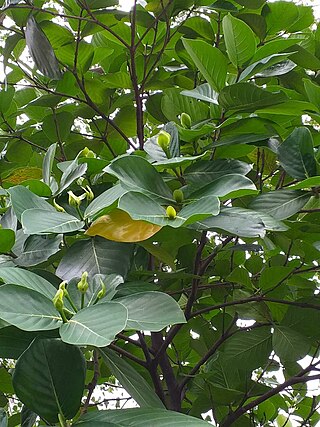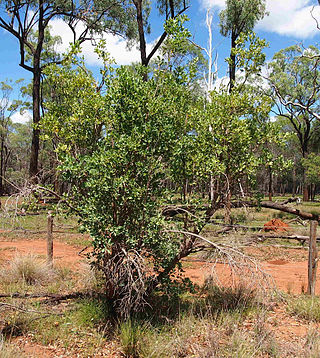
Royal Botanic Gardens, Kew is a non-departmental public body in the United Kingdom sponsored by the Department for Environment, Food and Rural Affairs. An internationally important botanical research and education institution, it employs 1,100 staff. Its board of trustees is chaired by Dame Amelia Fawcett.

Rubiaceae is a family of flowering plants, commonly known as the coffee, madder, or bedstraw family. It consists of terrestrial trees, shrubs, lianas, or herbs that are recognizable by simple, opposite leaves with interpetiolar stipules and sympetalous actinomorphic flowers. The family contains about 14,100 species in about 580 genera, which makes it the fourth-largest angiosperm family. Rubiaceae has a cosmopolitan distribution; however, the largest species diversity is concentrated in the tropics and subtropics. Economically important genera include Coffea, the source of coffee; Cinchona, the source of the antimalarial alkaloid quinine; ornamental cultivars ; and historically some dye plants.

Carpoxylon macrospermum is a species of palm tree endemic to Vanuatu, and the only species in the genus Carpoxylon.

Canthium is a genus of flowering plants in the family Rubiaceae. They are shrubs and small trees. The leaves are deciduous and the stems are usually thorny.
Glionnetia is a monotypic genus of flowering plants in the family Rubiaceae. The genus contains only one species, viz. Glionnetia sericea, which is endemic to Mahé and Silhouette Island in the Seychelles. The species thrives mainly on high ridges in the mountains and it does not seem to grow well at lower altitudes. Glionnetia sericea is a small flower with paniculate terminal inflorescences and it has capsules that are dispersed by wind.

Psydrax is a genus of flowering plants in the family Rubiaceae. It consists of trees, shrubs, and a few lianas in the paleotropics.
Bulbophyllum keekee is a species of orchid in the genus Bulbophyllum, native to New Caledonia. It is protected in the northern province.

Coprosma nitida, the mountain currant or shining currant, is a shrub species endemic to south-east Australia. It is a shrub with small, glossy leaves, occasional spines on the end of its branchlets, and small bright red-orange fruits.

Neonauclea is a genus of flowering plants in the family Rubiaceae. It comprises about 71 species. Neonauclea is a genus of shrubs and trees They are indigenous to China, India, Southeast Asia, Wallacea, New Guinea and Australia.
John Dransfield is former head of palm research at the Royal Botanic Gardens, Kew, United Kingdom.

Coelospermum reticulatum is a species of flowering plant in the family Rubiaceae. It is native to New Guinea, the Northern Territory, and Queensland. Its natural habitat is dry rainforest and moister Eucalyptus woodland. The plant is an important source of dye for Aboriginal people. The former genus Pogonolobus with its sole species, Pogonolobus reticulatus, has been synonymised with this species.

Pyrostria revoluta, formerly Scyphochlamys revoluta, is a species of flowering plant in the family Rubiaceae that lives on the island of Rodrigues.

Morindeae is a tribe of flowering plants in the family Rubiaceae. The tribe contains about 165 species in 5 genera, found mainly in the tropics and subtropics.

Agrostistachys indica is a species of plant in the family Euphorbiaceae, known in Singapore as the leaf litter plant. The species is widespread across much of Southeast Asia as well as New Guinea, India, and Sri Lanka.

Gynochthodes jasminoides is a woody climber or a scrambling shrub in the family Rubiaceae. In Australia it is found on the northern and eastern coasts, in Western Australia, the Northern Territory, Queensland, Victoria, and New South Wales.

Aitchisonia rosea is a species of flowering plant in the family Rubiaceae. It is a subshrub native to south-central Iran, Afghanistan, and Pakistan. It is the sole species in genus Aitchisonia.

Max Udo Hollrung was a German botanist, and an early specialist in phytopathology. He was the first university teacher in Germany to be appointed to teach on the subject of plant diseases and plant protection at a university. The standard author abbreviation Hollrung is used to indicate this person as the author when citing a botanical name.

Amylotheca is a genus of hemi-parasitic aerial shrubs in the family Loranthaceae, found in Borneo, Malaysia, New Caledonia, New Guinea, Australia, Sumatra, Thailand, Vanuatu, and Philippines

Calyptrocalyx hollrungii is a palm species in the family Arecaceae, and is native to Papua New Guinea and to the Indonesian part of New Guinea, Western New Guinea.
Calyptrocalyx amoenus is a palm species in the family Arecaceae, and is native to Papua New Guinea and to the Indonesian part of New Guinea, Western New Guinea.















